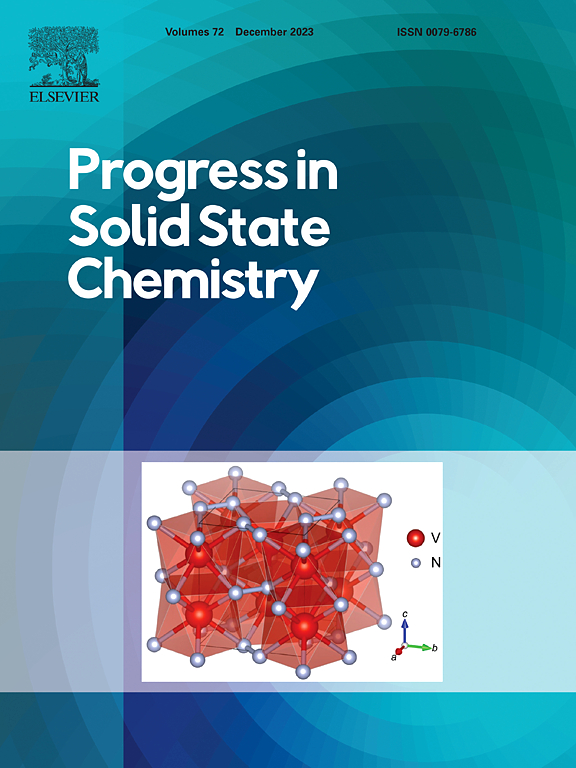Original mechanism of transformation from soft metallic (sp2/sp3) C12 to ultra-dense and ultra-hard (sp3) semi-conducting C12: Crystal chemistry and DFT characterizations
IF 10.5
2区 化学
Q1 CHEMISTRY, INORGANIC & NUCLEAR
引用次数: 0
Abstract
An original mechanism is proposed for a pressure-induced transformation of orthorhombic C12 from ground state normal pressure (NP) sp2/sp3 allotrope to ultra-dense and ultra-hard high pressure HP sp3 form. Upon volume decrease, the trigonal C![]() C parallel segments characterizing glitter-like tfi topology of NP C12 change to crossing C–C segments with the loss of sp2 character accompanied by a large densification with ρ = 3.64 g/cm3, larger than diamond, defining a novel orthorhombic HP C12 with 44T39 topology. The crystal chemistry engineering backed with quantum density functional theory DFT-based calculations let determine the ground state structures and energy derived physical properties. Furthering on that, the E(V) equations of states (EOS) let define the equilibrium NP(E0,V0) allotrope at lower energy and higher volume versus HP(E0,V0) allotrope at higher energy and smaller volume. A potential pressure induced transformation NP→HP was estimated at ∼100 GPa, reachable with a diamond anvil cell DAC. Both allotropes were found cohesive and mechanically stable with low and large Vickers hardness magnitudes: HV(tfi C12) = 24 GPa and HV(44T39 C12) = 90 GPa; the latter being close to diamond hardness (HV ∼95 GPa). Besides, both allotropes were found dynamically stable with positive phonon frequencies and a spectroscopic signature of C
C parallel segments characterizing glitter-like tfi topology of NP C12 change to crossing C–C segments with the loss of sp2 character accompanied by a large densification with ρ = 3.64 g/cm3, larger than diamond, defining a novel orthorhombic HP C12 with 44T39 topology. The crystal chemistry engineering backed with quantum density functional theory DFT-based calculations let determine the ground state structures and energy derived physical properties. Furthering on that, the E(V) equations of states (EOS) let define the equilibrium NP(E0,V0) allotrope at lower energy and higher volume versus HP(E0,V0) allotrope at higher energy and smaller volume. A potential pressure induced transformation NP→HP was estimated at ∼100 GPa, reachable with a diamond anvil cell DAC. Both allotropes were found cohesive and mechanically stable with low and large Vickers hardness magnitudes: HV(tfi C12) = 24 GPa and HV(44T39 C12) = 90 GPa; the latter being close to diamond hardness (HV ∼95 GPa). Besides, both allotropes were found dynamically stable with positive phonon frequencies and a spectroscopic signature of C![]() C high frequency bands in tfi C12. The electronic band structures show a metallic behavior for NP tfi C12 and a small band gap for HP 44T39C12 letting assign semiconducting properties. The work is meant to open further the scope of C (sp2)→C (sp3) transformation mechanisms that are fundamental in solid state physics and chemistry.
C high frequency bands in tfi C12. The electronic band structures show a metallic behavior for NP tfi C12 and a small band gap for HP 44T39C12 letting assign semiconducting properties. The work is meant to open further the scope of C (sp2)→C (sp3) transformation mechanisms that are fundamental in solid state physics and chemistry.
软金属(sp2/sp3) C12向超致密超硬(sp3)半导体C12转变的原始机理:晶体化学和DFT表征
提出了一种压力诱导正交C12从基态常压(NP) sp2/sp3同素异形体向超致密超硬高压HP sp3形态转变的原始机制。当体积减小时,具有发光样tfi拓扑的三角形CC平行段转变为交叉C-C段,失去sp2特征,并伴随着比金刚石大的ρ = 3.64 g/cm3的大密度,定义了具有44T39拓扑的新型正交型HP C12。以量子密度泛函理论为基础的晶体化学工程计算可以确定基态结构和能量衍生的物理性质。在此基础上,E(V)状态方程(EOS)定义了低能量和高体积下的平衡NP(E0,V0)同素异形体与高能量和小体积下的平衡HP(E0,V0)同素异形体。潜在压力诱导的转化NP→HP估计在~ 100 GPa,用金刚石砧细胞DAC可以达到。两种同素异构体均具有黏合性和机械稳定性,维氏硬度大小分别为:HV(tfi C12) = 24 GPa和HV(44T39 C12) = 90 GPa;后者接近金刚石硬度(HV ~ 95 GPa)。此外,这两种同素异形体在tfi - C12中具有正声子频率和CC高频光谱特征的动态稳定性。电子能带结构显示出NP tfi C12的金属行为和HP 44T39C12的小带隙,使其具有半导体性质。这项工作旨在进一步打开C (sp2)→C (sp3)转化机制的范围,这是固态物理和化学的基础。
本文章由计算机程序翻译,如有差异,请以英文原文为准。
求助全文
约1分钟内获得全文
求助全文
来源期刊

Progress in Solid State Chemistry
化学-无机化学与核化学
CiteScore
14.10
自引率
3.30%
发文量
12
期刊介绍:
Progress in Solid State Chemistry offers critical reviews and specialized articles written by leading experts in the field, providing a comprehensive view of solid-state chemistry. It addresses the challenge of dispersed literature by offering up-to-date assessments of research progress and recent developments. Emphasis is placed on the relationship between physical properties and structural chemistry, particularly imperfections like vacancies and dislocations. The reviews published in Progress in Solid State Chemistry emphasize critical evaluation of the field, along with indications of current problems and future directions. Papers are not intended to be bibliographic in nature but rather to inform a broad range of readers in an inherently multidisciplinary field by providing expert treatises oriented both towards specialists in different areas of the solid state and towards nonspecialists. The authorship is international, and the subject matter will be of interest to chemists, materials scientists, physicists, metallurgists, crystallographers, ceramists, and engineers interested in the solid state.
 求助内容:
求助内容: 应助结果提醒方式:
应助结果提醒方式:


